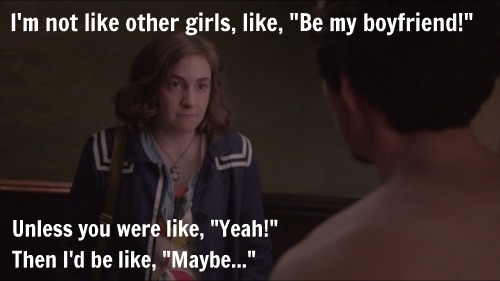I
have found the HBO show Girls to be a
source of media entertainment that both battles traditional gender stereotypes
and also conforms to them. In Season 1 Episode 4, “Hannah’s Diary,” traditional
gender roles are upheld and validated in a variety of scenes, causing me to
pause and think about just how progressive and feminist the show could really
be. Girls’ writer and protagonist,
Lena Dunham, prides herself on resisting cultural norms for unrealistic
feminine beauty and sex appeal and standing up for her gender. But how original
is she really?
In
this particular episode, Hannah depicts traditional female stereotypical traits
when she is clingy and emotional regarding her very distant lover, Adam. One
scene shows Hannah arriving at Adam’s door unannounced to inform him that they
are ending. Although all she receives is silence, one physical touch has her
falling on him immediately and gratifying his behavior through sex, providing
an example of the stereotypical dependent female while also reinforcing the
idea that the ‘real’ man provides attention in order to receive sex.

Further
evidence of what being a “real man” entails is obvious when Charlie reads an
entry in Hannah’s diary belittling his “feminine qualities.” To female audience
members around the same age as Hannah and Marni, they observe that it is
embarrassing and undesirable as a social female to date someone who doesn’t
exhibit the qualities that should bespeak a penis: distance and dominance. This
message is implicitly evident in Marnie’s distaste in Charlie despite his love asd
well as in the words Hannah uses to describe him.

In
Holz, Gibson, and Ivory’s article, Gendered Relationships on Television:
Portrayals of the Same-Sex and Heterosexual Couples (2009), they confirm “Women
are seen as passive, nurturant, and dependent, and men are seen as aggressive,
competitive, and independent” (p. 172). Hannah’s behavior, as well as her
ridicule of Charlie’s lack of traditional masculinity, provides evidence that
these traits are supported in this episode. Also, gender schema theory proposes
that children learn cultural definitions of maleness and femaleness, which are
linked to a network of sex-linked associations, that are invoked when absorbing
and evaluating new information (Holz, Gibson, and Ivory, 2009, p. 176). The young,
susceptible female audience of Girls
has much to learn from these depictions, and it is not positive.
While
some consider Girls to be a feminist
show, it is evident in this episode, through the embarrassment Charlie suffers
for being sensitive and affectionate and Hannah’s dependency on a distant male
figure, that it works to reinforce stereotypes and conventional ideas regarding
gender characteristics. Before thinking about analyzing this episode, I had
never considered the possibility that Girls might be sending out the wrong
messages. It goes to show the potential for duplicity and incongruity all media
has, especially when widely accepted for its supposedly feminist message, like Girls is, and the ability for this to be
swept under the rug.
References
Dunham, L.
(2012). Hannah’s Diary. HBO. Season
1, Episode 4.
Holz Ivory, A., Gibson, R., & Ivory, J. D.
(2009). Gendered relationships on television: Portrayals of same-sex and
heterosexual couples. Mass Communication & Society, 12(2), 170-192.
doi: 10.1080/15205430802169607
No comments:
Post a Comment
Note: Only a member of this blog may post a comment.